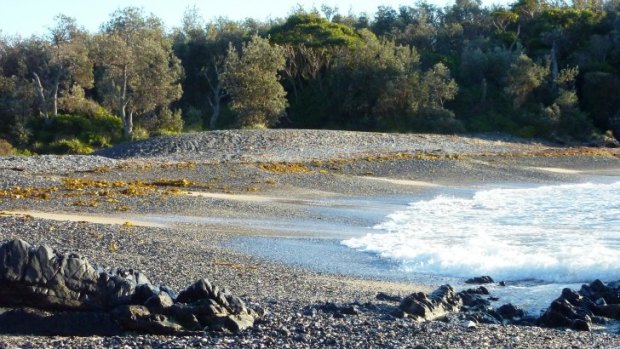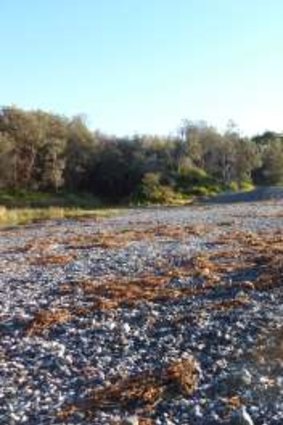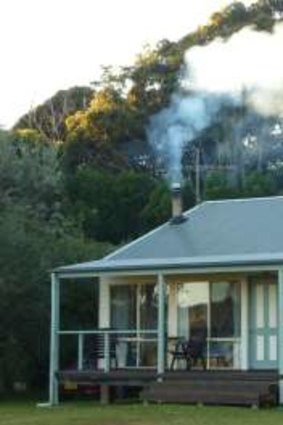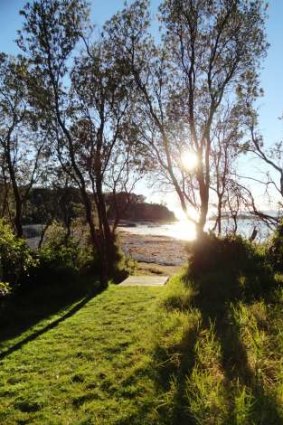
Billys Beach complete with its pebbles and shingle duneCredit: Tim the Yowie Man
It’s not what I expected. Instead of golden sand stretching from one end of idyllic Billy’s Beach to the other, the entire beach is covered with a pile of gravel. The pebbles on this secluded south coast beach are so uniform in size and so numerous that on first glance it resembles a road-side gravel dump. I pick my way through the pebbles towards the back of the beach where there’s a large dune over five metres in height and at least 60-70 metres long made entirely of these pebbles. It’s extraordinary. I’ve never seen anything like this in Australia. Sure you’ll find them in England, but not on our beautiful, sandy south coast beaches.
Where did all the pebbles come from? A quick look on my smartphone and Google Earth suggests that it was a sandy beach when last photographed, and to add further intrigue, a quick exploration of the adjoining beaches reveals they are completely pebble-free.
Where have the pebbles on Billy’s come from? Has a recent flood washed them down the small creek flowing in the nearby gully? Have they been dredged out of the ocean following a spill from a gravel-laden cargo ship?

Atop the shingle dune at Billys BeachCredit: Tim the Yowie Man
Baffled, I take a few photos and head into nearby Narooma and confront a few locals at the pub with my photos. They haven’t even heard of Billy’s Beach, let alone the source of its mysterious pebbles. Even a web search fails to turn anything up.
In fact, the only clue as to the pile of gravel is in the compendium in my room at the nearby Mystery Bay Cottages, which I turn to as a last resort. It reads: ‘‘The shingle dune at the rear of Billy’s Beach is all that remains of a huge gravel deposit which covered the beach completely after a King Tide and storm in 1974.’’
Heck. Imagine that, you go to bed one night only to wake up the next day to discover your sun-kissed favourite stretch of sand which you’ve been holidaying on for decades has seemingly vanished into thin air and been replaced by a pile of gravel. It would be a shock.

Mystery Bay Cottages - a perfect place from where to explore the riddle of Billys BeachCredit: Tim the Yowie Man
The explanation sounds logical enough, but doesn’t explain why the adjacent beaches are also covered in the gravel or where the gravel comes from?
The next morning, while checking out, I have a chat to Kate Jackson who, along with her husband Nigel, has owned Mystery Bay Cottages for 10 years. Although Kate can’t shed any further light on the source of the puzzling pebbles, but due to its ever-changing nature it’s one of her favourite south coast beaches. ‘‘We love Billy’s – when you go down there you never know what to expect – one day it might be sandy, the next covered in gravel – it’s a great place for kids to explore,’’ she says.
Wanting to get to the bottom of this unusual whodunit I eventually track down Norman Lenehan, coastal and flood management planner with Eurobodalla Shire Council, who confirms that 1974 was a benchmark year for coastal erosion. ‘‘There were a number of large storms fed by a number of big east coast lows, so local stories of the beach being lost in the 1970s are likely to be very accurate.’’

Sunrise over Billys BeachCredit: Tim the Yowie Man
As to the source of the pebbles? According to Norman: ‘‘They are probably from the cliffs surrounding the beach, which wave energy over many thousands of years has slowly eroded. These shingles would have been slowly covered by sand supplied from near shore currents.’’ Norman also offers a plausible theory for the variability in the number of pebbles on the beach over time (which could explain my Google Earth conundrum).‘‘It takes a lot longer for the sand to wash back in over the pebbles than for it to be stripped off by a big storm event – the sand can virtually disappear overnight where as it may take several years to be washed back in,’’ explains the beach aficionado.
Norman also reckons he knows why surrounding beaches aren’t inflicted by the gravel deposit. ‘‘Due to the nature of Billy’s Beach – only a hundred metres or so across and with a headland at either side, there’s likely to be more powerful wave energy than the more open and longer surrounding beaches and thereby more erosion in a storm event. The narrow width and deep-set nature of the beach also means the beach is likely to have a localised movement of sediment, therefore, once the sand is washed out it takes a lot longer to be resupplied with sand from the long-shore sand drifts,’’ Norman says.‘‘Unlike the north coast, which has a series of very long beaches, the south coast has a lot of small pocket beaches that have their own unique characteristics and behaviour, such as Billy’s.’’
Mystery solved.
If you have any photos of Billy’s Beach sans pebbles, I’d love to see them, especially any which pre-date the landmark 1974 storms.
FACT FILE
Billy’s Beach is a 10-minute drive south of Narooma. It’s just north of Mystery Bay and is best accessed by parking at the Mystery Bay Campground from where it’s a 200-metre walk.
Sign up for the Traveller newsletter
The latest travel news, tips and inspiration delivered to your inbox. Sign up now.